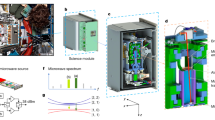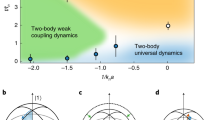Abstract
The problem of three interacting quantal bodies, in its various guises, seems deceptively simple, but it has also provided striking surprises, such as the Efimov effect1,2, which was confirmed experimentally3 only more than 35 years after its initial prediction. The importance of understanding the three-body problem was magnified by the explosion of ultracold science following the formation of Bose–Einstein condensates in 1995 (ref. 4). For ultracold gases, three-body recombination (where B+B+B collide to form B2+B) was quickly recognized as the main loss process and connected5,6,7,8 with the Efimov effect in the ‘universal’ realm of very large atom–atom scattering lengths a. The problem of four interacting bodies challenges theory far more than the three-body quantal problem. Some key insights have been achieved in recent years9,10,11,12,13,14,15,16. Here, we present a major extension of our understanding of the four-body problem in the universal large-a regime. Our results support a previous conjecture10 that two resonantly bound four-body states are attached to every universal three-body Efimov resonance and they improve the calculated accuracy of their universal properties. A hitherto unanalysed feature found in ultracold-gas experiments3 supports this universal prediction, and it provides the first evidence of four-body recombination (where B+B+B+B form B3+B, B2+B+B or B2+B2).
This is a preview of subscription content, access via your institution
Access options
Subscribe to this journal
Receive 12 print issues and online access
$259.00 per year
only $21.58 per issue
Buy this article
- Purchase on SpringerLink
- Instant access to full article PDF
Prices may be subject to local taxes which are calculated during checkout

 converging at large R to the atom–trimer thresholds.
converging at large R to the atom–trimer thresholds.

Similar content being viewed by others
References
Efimov, V. Weakly bound states of three resonantly interacting particles. Yad. Fiz. 12, 1080–1091 (1970); Sov. J. Nucl. Phys. 12, 589-595 (1971).
Efimov, V. Energy levels of three resonantly interacting particles. Nucl. Phys. A 210, 157–188 (1973).
Kraemer, T. et al. Evidence for Efimov quantum states in an ultracold gas of caesium atoms. Nature 440, 315–318 (2006).
Anderson, M. H., Ensher, J. R., Matthews, M. R., Wieman, C. E. & Cornell, E. A. Observation of Bose–Einstein condensation in a dilute atomic vapor. Science 269, 198–201 (1995).
Esry, B. D., Greene, C. H. & Burke, J. P. Jr. Recombination of three atoms in the ultracold limit. Phys. Rev. Lett. 83, 1751–1754 (1999).
Nielsen, E. & Macek, J. H. Low-energy recombination of identical bosons by three-body collisions. Phys. Rev. Lett. 83, 1566–1569 (1999).
Bedaque, P. F., Braaten, E. & Hammer, H.-W. Three-body recombination in Bose gases with large scattering length. Phys. Rev. Lett. 85, 908–911 (2000).
Braaten, E. & Hammer, H. W. Universality in few-body systems with large scattering length. Phys. Rep. 428, 259–390 (2006).
Platter, L., Hammer, H. & Meißner, U. Four-boson system with short-range interactions. Phys. Rev. A 70, 52101 (2004).
Hammer, H. W. & Platter, L. Universal properties of the four-body system with large scattering length. Eur. Phys. J. A 32, 113–120 (2007).
Yamashita, M. T., Tomio, L., Delfino, A. & Frederico, T. Four-boson scale near a Feshbach resonance. Europhys. Lett. 75, 555–561 (2006).
Hanna, G. J. & Blume, D. Energetics and structural properties of three-dimensional bosonic clusters near threshold. Phys. Rev. A 74, 063604 (2006).
Petrov, D. S., Salomon, C. & Shlyapnikov, G. V. Weakly bound dimers of fermionic atoms. Phys. Rev. Lett. 93, 090404 (2004).
von Stecher, J. & Greene, C. H. Spectrum and dynamics of the BCS-BEC crossover from a few-body perspective. Phys. Rev. Lett. 99, 090402 (2007).
D’Incao, J. P., Rittenhouse, S. T., Mehta, N. P. & Greene, C. H. Dimer–dimer collisions at finite energies in two-component Fermi gases. Phys. Rev. A 79, 030501 (2009).
Wang, Y. & Esry, B. D. Efimov trimer formation via ultracold four-body recombination. Phys. Rev. Lett. 102, 133201 (2009).
Köhler, T., Góral, K. & Julienne, P. S. Production of cold molecules via magnetically tunable Feshbach resonances. Rev. Mod. Phys. 78, 1311–1362 (2006).
Macek, J. H. Properties of autoionizing states of He. J. Phys. B 1, 831–843 (1968).
von Stecher, J. Trapped Ultracold Atoms With Tunable Interactions. PhD thesis, Univ. of Colorado, Boulder (2008); <http://jilawww.colorado.edu/pubs/thesis/vonstecher/>.
Coelho, H. T. & Hornos, J. E. Proof of basic inequalities in the hyperspherical formalism for the N-body problem. Phys. Rev. A 43, 6379–6381 (1991).
Suzuki, Y. & Varga, K. Stochastic Variational Approach to Quantum-Mechanical Few-Body Problems. (Springer, 1998).
D’Incao, J. P. & Esry, B. D. Manifestations of the Efimov effect for three identical bosons. Phys. Rev. A 72, 032710 (2005).
Esry, B. D. & Greene, C. H. Quantum physics: A ménage à trois laid bare. Nature 440, 289–290 (2006).
D’Incao, J. P., Greene, C. H. & Esry, B. D. The short-range three-body phase and other issues impacting the observation of Efimov physics in ultracold quantum gases. J. Phys. B 42, 044016 (2009).
Danilov, G. S. On the three-body problem in the case of short-range forces. Zh. Eksp. Teor. Fiz. 40, 498–507 (1961); Sov. Phys. JETP 13, 349–355 (1961).
Knoop, S. et al. Observation of an Efimov-like trimer resonance in ultracold atom–dimer scattering. Nature Phys. 5, 227–230 (2009).
Amado, R. D. & Greenwood, F. C. There is no Efimov effect for four or more particles. Phys. Rev. D 7, 2517–2519 (1973).
Jonsell, S. Efimov states for systems with negative scattering lengths. Europhys. Lett. 76, 8–14 (2006).
Lee, M. D., Koehler, T. & Julienne, P. S. Excited Thomas–Efimov levels in ultracold gases. Phys. Rev. A 76, 012720 (2007).
Massignan, P. & Stoof, H. T. C. Efimov states near a Feshbach resonance. Phys. Rev. A 78, 030701 (2008).
Mehta, N. P., Rittenhouse, S. T., D’Incao, J. P., von Stecher, J. & Greene, C. H. A general theoretical description of N-body recombination. Preprint at <http://arxiv.org/abs/0903.4145> (2009).
Ferlaino, F. et al. Evidence for universal four-body states tied to an Efimov trimer. Phys. Rev. Lett. 102, 140401 (2009).
Acknowledgements
This work was supported in part by the National Science Foundation. We are indebted to N. Mehta and S. Rittenhouse for extensive discussions and for access to their unpublished derivations before publication. We also thank F. Ferlaino, S. Knoop, H.-C. Nägerl and R. Grimm from the Innsbruck group for discussions about their experimental data.
Author information
Authors and Affiliations
Contributions
The authors contributed equally to the manuscript.
Corresponding author
Supplementary information
Supplementary Information
Supplementary Information (PDF 477 kb)
Rights and permissions
About this article
Cite this article
von Stecher, J., D’Incao, J. & Greene, C. Signatures of universal four-body phenomena and their relation to the Efimov effect. Nature Phys 5, 417–421 (2009). https://doi.org/10.1038/nphys1253
Received:
Accepted:
Published:
Issue date:
DOI: https://doi.org/10.1038/nphys1253
This article is cited by
-
Four-Boson Continuous Scale Symmetry Breaking
Few-Body Systems (2019)
-
Efimov States in an Ultracold Gas: How it Happened in the Laboratory
Few-Body Systems (2019)
-
Tetramers of Two Heavy and Two Light Bosons
Few-Body Systems (2018)
-
Production of dark-matter bound states in the early universe by three-body recombination
Journal of High Energy Physics (2018)
-
Unitarity and Discrete Scale Invariance
Few-Body Systems (2017)



